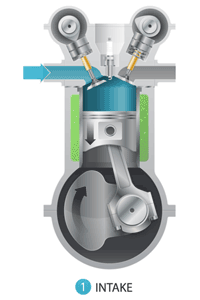How an Internal Combustion Engine Works?

Internal combustion is based on the idea that you can create lots of energy when you burn gasoline in a small enclosed area. When you are able to harness the expanding gas that comes from this process, then you have created the core of an internal combustion engine.
From there, the energy from this gas is converted into motion. Virtually every car that you see on the road uses a four-stroke combustion cycle to create motion from gasoline. Keep reading to understand (and see) just how a gas engine works that’s found in most vehicles on the road today.

HOW A 4-STROKE ENGINE WORKS
The four-stroke engine process is also known as the Otto Cycle. A German engineer named Nicolaus Otto was the first person to invent and patent a four-stroke gas engine. Each step in the process is named with the word stroke in it; intake stroke, compression stroke, power stroke, and exhaust stroke.
It is important to understand the term Otto Cycle because it is different than the combustion cycle that diesel engines used known as the “Diesel Cycle.” This cycle is also a four-stroke process, but the details of how each process works are different than the Otto Cycle.
Below are the four unique processes for combustion to take place in a typical gasoline engine.
#1 – INTAKE STROKE

- The intake stroke is the first part of the internal combustion process and is basically the aspiration or breathing of the engine. What happens is there’s a connecting rod that connects the piston to the crankshaft.
- The piston moves from the top to the bottom once the intake valve opens up. From there, the piston allows gasoline and air to get into the engine from the cylinder.
- The intake stroke occurs when the gasoline mixes with the air. There doesn’t have to be a lot of gasoline for this to work either. Just a small drop of gasoline mixed together with air will create the stroke.
- Intake Valve = Open
- Exhaust Valve = Closed
#2 – COMPRESSION STROKE

- After that, the piston moves upwards and compresses the mixture of air and gasoline to give it a more powerful effect. This is known as the compression stroke.
- Intake valve = Closed
- Exhaust valve = Closed
#3 – POWER STROKE

- The piston eventually makes it back to the top after compressing the air and gasoline mixture. Once it does, a spark is discharged by the spark plug which causes the gasoline to ignite.
- There is a mini-explosion inside of the cylinder where the gasoline charge is still active. This is known as the power or combustion stroke.
- Intake valve = Closed
- Exhaust valve = Closed
#4 – EXHAUST STROKE

- After the explosion, the piston falls back down to the bottom and causes the exhaust valve to open up. All of the exhaust that was created in the cylinder starts to leave through the exhaust valve and comes out of the car’s tailpipe.
- The engine has now gone through one rotation of the four-stroke combustion cycle.
- Intake valve = Closed
- Exhaust valve = Open
The cycle keeps repeating over and over again as you put your foot on the gas pedal to accelerate the vehicle. If there was a problem with any one of these strokes, then it would prevent the whole combustion cycle from happening. Either that or it would gradually damage the components of the engine.
Some cars may have slight differences in this process, like with the number of cylinders it has. But the overall concept is still the same.



